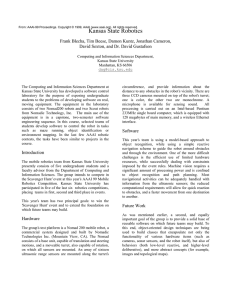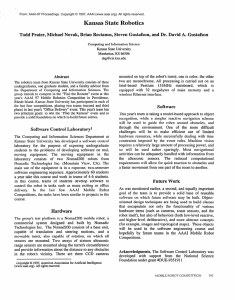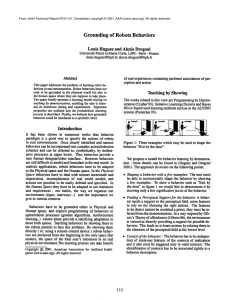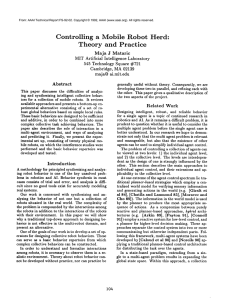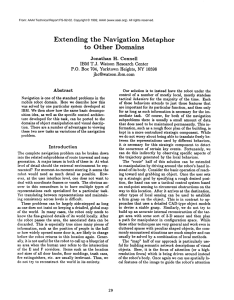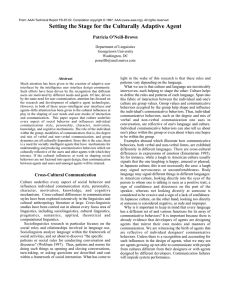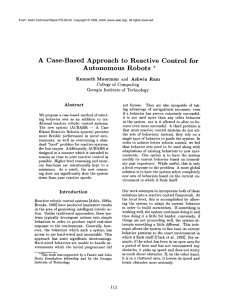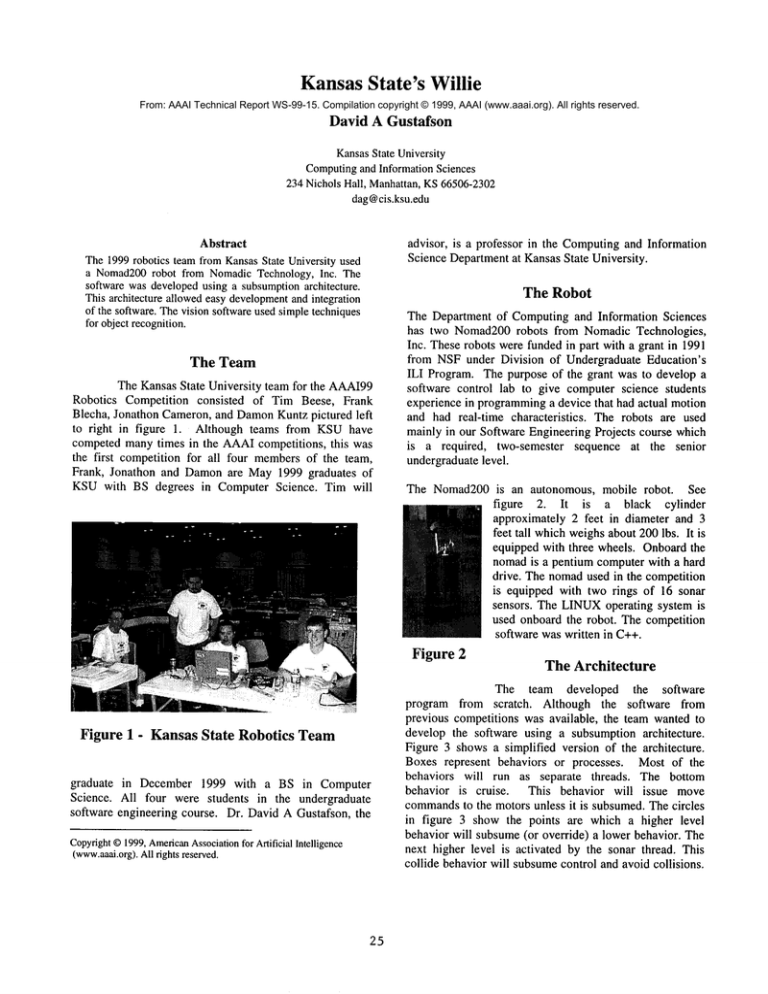
Kansas State’s Willie
From: AAAI Technical Report WS-99-15. Compilation copyright © 1999, AAAI (www.aaai.org). All rights reserved.
David A Gustafson
KansasState University
Computing
and InformationSciences
234 Nichols Hall, Manhattan,KS66506-2302
dag@cis.ksu.edu
Abstract
The 1999robotics team fromKansasState University used
a Nomad200robot from NomadicTechnology, Inc. The
software wasdevelopedusing a subsumptionarchitecture.
This architecture allowedeasy development
and integration
of the software. Thevision softwareused simpletechniques
for object recognition.
advisor, is a professor in the Computingand Information
Science Departmentat KansasState University.
The Robot
The Team
The Kansas State University team for the AAAI99
Robotics Competition consisted of Tim Beese, Frank
Blecha, Jonathon Cameron, and DamonKuntz pictured left
to right in figure 1. Although teams from KSUhave
competed manytimes in the AAAIcompetitions, this was
the first competition for all four membersof the team,
Frank, Jonathon and Damonare May 1999 graduates of
KSUwith BS degrees in Computer Science. Tim will
The Department of Computing and Information Sciences
has two Nomad200robots from Nomadic Technologies,
Inc. These robots were funded in part with a grant in 1991
from NSF under Division of Undergraduate Education’s
ILI Program. The purpose of the grant was to develop a
software control lab to give computer science students
experience in programminga device that had actual motion
and had real-time characteristics.
The robots are used
mainly in our Software Engineering Projects course which
is a required, two-semester sequence at the senior
undergraduatelevel.
The Nomad200 is an autonomous, mobile robot. See
figure 2. It is a black cylinder
approximately 2 feet in diameter and 3
feet tall whichweighsabout 200 lbs. It is
equipped with three wheels. Onboardthe
nomadis a pentium computer with a hard
drive. The nomadused in the competition
is equipped with two rings of 16 sonar
sensors. The LINUXoperating system is
used onboard the robot. The competition
software was written in C++.
Figure 2
Figure 1 - Kansas State Robotics Team
graduate in December 1999 with a BS in Computer
Science. All four were students in the undergraduate
software engineering course. Dr. David A Gustafson, the
Copyright
©1999,American
Association
for Artificial Intelligence
(www.aaai.org).
Allfightsreserved.
25
The Architecture
The team developed the software
program from scratch. Although the software from
previous competitions was available, the team wanted to
develop the software using a subsumption architecture.
Figure 3 shows a simplified version of the architecture.
Boxes represent behaviors or processes. Most of the
behaviors will run as separate threads. The bottom
behavior is cruise. This behavior will issue move
commands
to the motors unless it is subsumed.The circles
in figure 3 show the points are which a higher level
behavior will subsume(or override) a lower behavior. The
next higher level is activated by the sonar thread. This
collide behavior will subsumecontrol and avoid collisions.
Other threads run the vision (camera) and sound (mic)
routines. The mapprocess maintains an occupancy grid of
the area to keep track of areas already explored. These
behaviors will direct the motion either toward a possible
object or in a search pattern to cover unexplored areas of
the competition.
This architecture was easy to understand and easy to
implement. The team members built the behaviors
separately and integrated the behaviors easily into the
complete system. The team did experience difficulty in
fine tuning the systemat the competitionsite. In particular,
Figure 3 - subsumption architecture
since the vision system can only be operated effectively
whenthe robot is stopped, the timing of picture taking is
critical. This was difficult to fine tune in this particular
implementation.
Vision
The team built simple vision recognition routines using the
Target Jr Vision System (www.tar~etir.org).
Since the
objects to be recognized were simple, an ad hoc approach
was used. Each object had an identification schemebased
on color, shape or both. Thresholdswere identified for the
colors and flooding was used to isolate the shape. Simple
comparisons of widths of the flooded area were used for
identification.
Conclusion
The team won second place in the scavenger hunt
competition. It was a learning experience for all members
of the team. Although Willie performed well, there was
muchroom for improvementin both search algorithms and
object identification.
26

